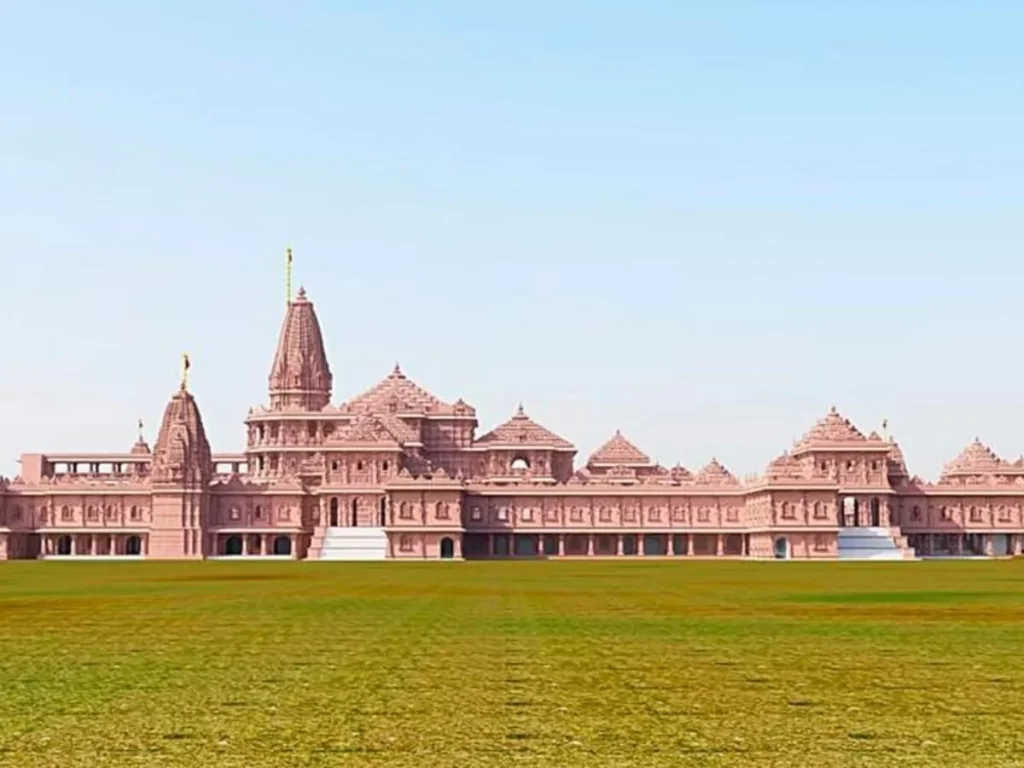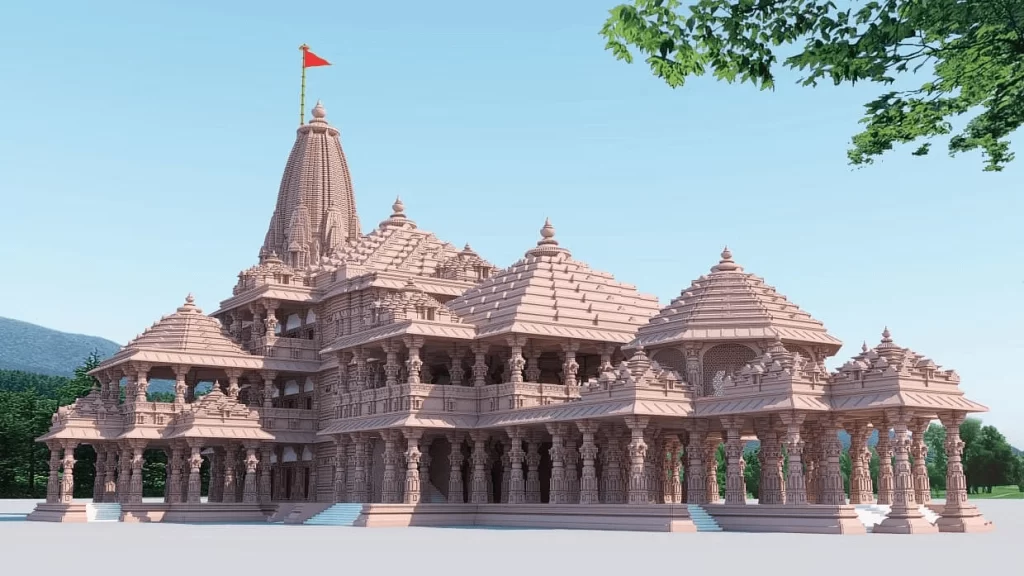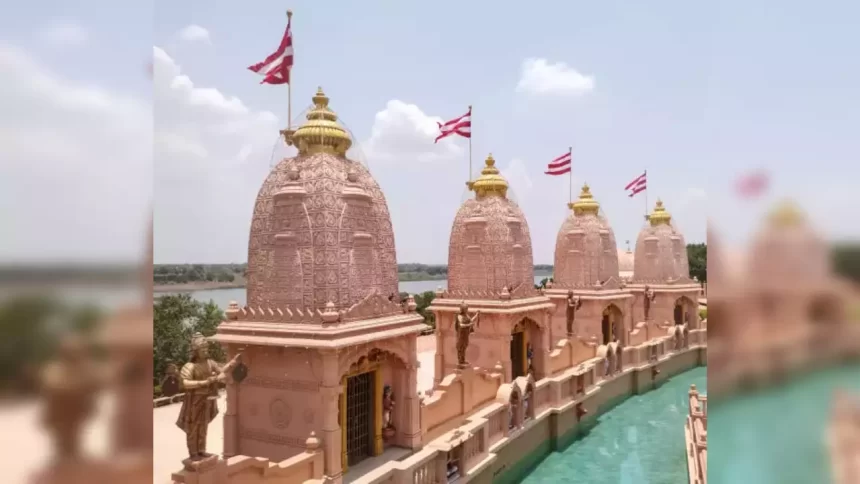Ayodhya Ram Mandir – The sacred town of Ayodhya in Uttar Pradesh has once again captured India’s imagination with the ongoing construction of a grand temple dedicated to the Hindu deity Lord Ram. This temple, known as the Ram Mandir, aims to honor the birthplace of the revered icon representing virtue, righteousness and moral rectitude. Beyond its religious significance, the temple complex promises to be a modern engineering feat combining ancient Hindu temple architecture with innovative techniques.
Historical Significance of Ayodhya Ram Mandir

The temple town of Ayodhya holds special meaning for Hindus as the mythical birthplace of Lord Ram, the protagonist of the epic Ramayana.
- Believed to be the capital of the ancient Kosala Kingdom, where Ram reigned as prince and later king -Mentioned in the Valmiki Ramayana and other Hindu texts as the divine city of Ram’s reign
- Site of historic Rama Janmabhoomi temple said to mark Ram’s birthplace
After India’s independence, the site became contentious due to the demolition of the 16th century Babri Masjid mosque built during the Mughal era. Many Hindus claimed the mosque had been built by demolishing a pre-existing Ram temple at Ram’s birth spot.
- Campaign grew to rebuild the Ram Mandir at the disputed site
- Land title suit was bitterly contested for decades between Hindu and Muslim groups
- Supreme Court ruled in 2019 that the entire site belongs to Hindus
The Ram Mandir ceremony in 2020 marked the resolution of this long-standing controversy and ushered in a new chapter in Ayodhya’s history.
A Vision for the Grand Temple

The ambitious Ram Mandir project aims to construct a massive Hindu place of worship befitting Lord Ram’s stature and Ayodhya’s heritage.
Patron Body
The temple is being built under the aegis of the Shri Ram Janmabhoomi Teerth Kshetra Trust.
Temple Design
The ornate temple complex covering a sprawling area has been conceived to showcase:
- Intricately carved pillars, walls and ceilings
- Soaring towers and domes
- Statues and symbolic sculptures
- Space for ritual circumambulation
The main temple will rise to 161 feet tall and span 5 acres. The entire campus will span over 100 acres.
Ayodhya Ram Mandir Architectural Style
The design combines:
- Nagara architecture – North Indian Hindu temple style
- Curvilinear towers
- Extensive ornamentation
- Tamil and Kerala temple styles from South India
- Pyramidal towers
- Elaborate gateways
This fusion of regional styles symbolizes integration of cultural and religious traditions.
Ayodhya Ram Mandir Construction Technology
Construction will utilize:
- Traditional materials like stone and marble
- Modern engineering techniques
- Earthquake resistance
- Laser cutting of stones
- Rainwater harvesting
Ayodhya Ram Mandir as a Spiritual Beacon

For India’s majority Hindu population, the Ram Mandir stands as a house of worship as well as a spiritual and cultural symbol with profound meaning.
Fulfillment of a Long Cherished Dream
The temple’s construction is the culmination of a multi-generational movement to restore a sacred Hindu site. It brings alive the poetic imagery of a divine Ayodhya city described in Hindu scriptures.
Awakening of Faith
The campaign to build the temple has awakened Hindu pride and rekindled devotion to Lord Ram and his universal teachings.
Message of Unity
Despite past divisions, the temple represents India’s communal harmony, with leaders across faiths participating in the foundation stone ceremony.
Testament to Endurance and Truth
To many believers, the temple’s fruition validates their unwavering faith in Lord Ram and his presence at the Janmabhoomi site.
Ayodhya is again gearing up to be a major global pilgrimage attraction like Vatican City, Mecca and Varanasi.
Architectural Excellence and Innovation

Beyond its religious essence, the Ram Mandir stands as an architectural feat bringing together ancient crafts and modern technology.
Blending Heritage Construction with Cutting-Edge Methods
Traditional carved stones are being integrated with modern structural engineering to construct the earthquake-resistant yet artistically ornate edifice.
Granite from Karnataka, Marble from Makrana
The temple employs the finest construction materials sourced from locations known for stone-working mastery.
Soil Testing and Foundation Design
Over 4,000 pillars will support the complex on a foundation designed to handle soil conditions and weight.
Skilled Artisans and Craftsmen
Thousands of sculptors, carvers and workers are involved in translating the architectural vision into reality.
Green Building Strategies
Sustainability features like rainwater harvesting and solar energy are being incorporated into the campus.
| Construction Factoids | Details |
|---|---|
| Total built up area | Over 8 Lakh sq. ft |
| Main temple height | 161 feet |
| Pillars planned | Over 4000 |
| Stone slabs required | 6.37 lakh |
| Expected completion date | 2024 CE |
The ambitious engineering behind the Ram Mandir construction will make it an architectural case study for future.
Conclusion
The Ram Mandir in Ayodhya symbolizes the resurgence of India’s civilizational glory. It brings alive myths and history through an intricately carved stone edifice standing on the banks of the Sarayu River. Beyond the religious significance, the state-of-the-art engineering techniques involved make the Ram Mandir a marquee project that marries spirituality and progress. The temple complex will be a beacon for faith, culture, and nationalism, inspiring generations of citizens and visitors.
For believers, the opportunity to offer prayers at the divine Janmabhoomi site of Lord Ram marks the fulfillment of a spiritual quest. For architects, historians and tourists, experiencing the temple’s intricate artisanship and aura of sacredness will be a highlight. The Ram Mandir provides a confluence of heritage and technology that aptly reflects India’s timeless ethos and vibrant future. As Ayodhya regain its mythic grandeur, the Ram Mandir is poised to be a world-famous temple that upholds sublime ideals while showcasing human enterprise and ingenuity.








